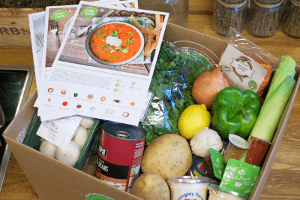Overview

The first Meal Kit delivery service started in 2007 in Europe. The concept quickly exploded and in less than 15 years it is estimated that the industry will be worth between $3 billion and $5 billion. What a Meal Kit service does it provides the subscriber to their front door pre-portioned ingredients for a number of meals every week. The customer can then take the ingredients and the provided recipe and create a home cooked meal. Meals on average take anywhere from 30 minutes to an hour for prep and cooking time. On average dinner meals from these services cost between $8 and $12 per person, per meal. Most meal kit companies require the customer to subscribe to the service. With a subscription every week the company will send the customer a predefined number of meals for a predefined number of people. The meals sent are based on preferences that the customer selects at the beginning and can include things like if the customer is a vegetarian, or enjoys seafood.
One of the main selling features of meal kit services are the recipes the companies offer. It allows the customer to try out 1 or more new dishes every week that they may have never considered making at home before. The meals usually are healthy and calorie conscious while still being flavorful.
Most popular meal kit services offer recipes for dinners only. This is starting to change as companies start offering breakfasts, lunches, deserts and other items to the menu for an extra cost. Niche markets are also emerging in the meal kit delivery service for food meals like smoothies.
For our list of reviews for companies in this industry please see our Meal Kit category.
History of Facts & Statistics
2019
- Meal kits sold in grocery stores now account for 60% of all meal kit user growth. [1]
- 14.3 million households purchased meal kits in the last half of 2018, up 3.8 million households from 2017. [1]
- In-store sales of Meal Kits totaled $93 million in 2018. [1]
- In 2018 online-only purchasers of Meal Kits was 60% of sales while grocery store purchasers was at 32%. 8% of sales was from customers who bought online and through grocery stores. [1]
References
2018
- Grocery chains like Rouses and ShopRite have begun offering their own meal kits at lower prices than Hellofresh and Blue Apron. [1]
- Walmart has announced its plans to roll out its own branded meal kit service in 2,000 store locations by the end of 2018. [1]
- Weight Watchers plans to offer a Meal Kit service later this year. [2]
- Kroger has acquired meal kit service Home Chef for $200 million initially with a possibility of $500 over a 5 year period. [3]
- Meal Kit company Chef'd closed it's doors and laid off all of it's employees. [4]
References
- Hello Fresh Overtakes Blue Apron in U.S., Acquires Green Chef
- Weight Watchers to Launch Meal Kit Service
- Kroger Acquires Home Chef Meal Kit Service, Giving Blue Apron Stock a Bump
- Meal Kit Company Chef’d Suspending Operations
2017
- It is estimated that between 2016 and 2021, e-commerce sales of food and beverage will reach $66 billion, a compound annual growth rate of 38%. [1]
- 41% of American adults visit cooking websites to find recipes. [1]
- Amazon announced a deal to buy Whole Foods Grocery for $13.7 billion. This puts a question mark on the meal kit industry as Amazon already has a grocery delivery service which is part of the appeal of meal kit services. [2]
- The meal kit delivery service Sun Basket which offers organic ingredients, has hired banks for an IPO that could take place later this year. [2]
- Amazon Meal Kits is a new product by Amazon that is being tested in select markets. It is not subscription based. [3]
- The meal kit industry is now worth $2.2 billion. [4]
- The second largest grocery chain Albertson Companies has purchased Plated for between $175 million to $200 million. [4]
References
- Meal Kit Subscriptions Surge
- Blue Apron Makes Lukewarm IPO Debut
- Amazon Testing its New Meal Kit Service in Select Markets
- Blue Apron Gets a Boost from Albertson’s Purchase of Plated
2016
- More than 170 meal kit businesses are in operation globally which includes niche operators (only 1 food type like smoothies, deserts, etc.. ). [1]
- Meal kit food delivery services generated more than $1 billion in sales, in 2015. The United States market accounts for 40% of this. [1]
- According to Technomic Research subscribers of meal kit services are typically older millennials equally split among the genders. 47% of subscribers have a household income of over $125 thousand and 23% more likely to rent their home. [1]
- 40% of subscribers to meal kit services are parents. [1]
- More than 150 meal kit delivery services in the United States. [2]
- It is projected that the meal kit industry will generate $1.5 billion in sales in 2016. [2]
References
2015
- Goldman Sachs research expects the meal kit industry to grow to between $3 billion and $5 billion by 2020. [1]
- Americans spend $1 trillion each year on food, which includes the $400 billion spent on dinner. [2]
- According to NPD Group, less than 60% of dinners eaten at home are home cooked. This is down from 71% in 1985. [2]
- Meal Kit customers are largely college-educated, dual-income families with no kids living in and around major metro areas. [3]
References
- How Plated Got Served [1]
- Inside Blue Apron and the Meal Kit Rush [1]
- The $5 Billion Battle For The American Dinner Plate [1]
2007
- Middagsfrid the first meal kit company was launched in Sweden by Kicki Theander. [1]
References
Annotations
- Pages change over time and while they contained the information presented here at the time of writing, it may have been updated or deleted











